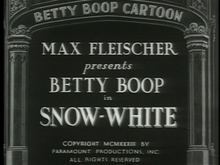Snow-White (1933 film)
| Snow-White | |
|---|---|
 | |
| Directed by | Dave Fleischer |
| Produced by | Max Fleischer |
| Starring | Mae Questel Billy Murray Cab Calloway (vocal chorus) |
| Animation by | Roland Crandall |
| Color process | Black and white |
Production company | |
| Distributed by | Paramount Pictures |
Release date |
|
Running time | 7 mins |
| Language | English |
Snow-White (also known as Betty Boop in Snow-White) is a 1933 American animated short in the Betty Boop series from Max Fleischer's Fleischer Studios.[1][2] Dave Fleischer was credited as director, although virtually all the animation was done by Roland Crandall, who received the opportunity to make Snow-White on his own as a reward for his several years of devotion to the Fleischer studio. The resulting film, which took six months to complete, is considered both Crandall's masterwork and an important milestone of the Golden age of American animation.
Synopsis
[edit]A magic mirror resembling Cab Calloway proclaims Betty Boop to be "the fairest in the land", much to the anger of the Queen. The Queen orders her guards Bimbo and Koko to execute Betty. With tears in their eyes, they take Betty into the forest; as they prepare to execute her, they spare her by destroying their weapons, but fall into a pit before they can free her. Betty escapes into a frozen river, which encloses her in a coffin of ice. This block slips downhill to the home of the seven dwarfs, who carry the frozen Betty into an enchanted cave, running into Koko and Bimbo. The evil Queen, now transformed into a witch, turns Koko into a ghost as he sings the St. James Infirmary Blues. With her rivals disposed of, the Queen again asks the magic mirror who the fairest in the land is, but the mirror explodes in a puff of magic smoke that returns Betty and Koko to their normal states and changes the Queen into a hideous and mysterious dragon-like monster. The dragon-like monster chases the protagonists until Bimbo grabs its tongue and yanks it, turning the creature inside out and causing it to flee away. Betty, Koko, and Bimbo dance around in a circle of victory as the film ends.[3]
Legacy
[edit]Koko's dancing (including some moves that look like the much later "moonwalk" and "dab") during the "St. James" number is rotoscoped from footage of Cab Calloway.[4][5]
The film was deemed "culturally significant" by the United States Library of Congress and selected for preservation in the National Film Registry in 1994. The same year, it was voted #19 of the 50 Greatest Cartoons of all time by members of the animation field.[6] The film is copyrighted by Paramount due to its copyright being renewed in 1961.[7]
See also
[edit]References
[edit]- ^ Zipes, Jack (2011). The Enchanted Screen: The Unknown History of Fairy-Tale Films. Routledge. p. 120. ISBN 9781135853952.
- ^ Westfahl, Gary (2005). The Greenwood Encyclopedia of Science Fiction and Fantasy. Vol. Themes, Works, and Wonders, Volume 3. Greenwood Publishing Group. p. 1238. ISBN 9780313329500.
- ^ Wells, Paul (2013). Understanding Animation. Routledge. pp. 74–75. ISBN 9781136158735.
- ^ Archived at Ghostarchive and the Wayback Machine: rahree (May 10, 2009), Koko the Clown sings "St. James Infirmary Blues" in Betty Boop's Snow White, retrieved May 14, 2018
- ^ Vilas-Boas, Eric; Maher, John, eds. (October 5, 2020). "The 100 Sequences That Shaped Animation". Vulture.
But in 1933, Fleischer Studios put Betty Boop and Koko the Clown in the seven-minute Betty Boop in Snow-White short animated by Roland C. Crandall, with a rotoscoped set piece in the middle, set to "St. James Infirmary Blues", performed by jazz artist Cab Calloway. [...] Here, Calloway seems to moonwalk along the animated landscape as Koko, arms out, singing a blues song about death and decay. When the witch casts her mirror over him, he becomes a ghost, at which point the rotoscoping gives seamlessly to impossible contortions.
- ^ Beck, Jerry (1994). The 50 Greatest Cartoons: As Selected by 1,000 Animation Professionals. Turner Publishing. ISBN 978-1878685490.
- ^ textsCatalog of Copyright Entries 1961 Motion Pictures Jan-Dec 3D Ser Vol 15 Pts 12-13
External links
[edit] Media related to Snow-White (1933 film) at Wikimedia Commons
Media related to Snow-White (1933 film) at Wikimedia Commons- Snow White at IMDb
- The short film Snow White is available for free viewing and download at the Internet Archive.
- 1933 films
- 1933 animated films
- 1930s American animated films
- 1930s animated short films
- United States National Film Registry films
- Films based on Snow White
- 1933 short films
- Betty Boop cartoons
- Short films directed by Dave Fleischer
- Paramount Pictures short films
- Fleischer Studios short films
- 1930s English-language films
- English-language short films
- American animated black-and-white films
